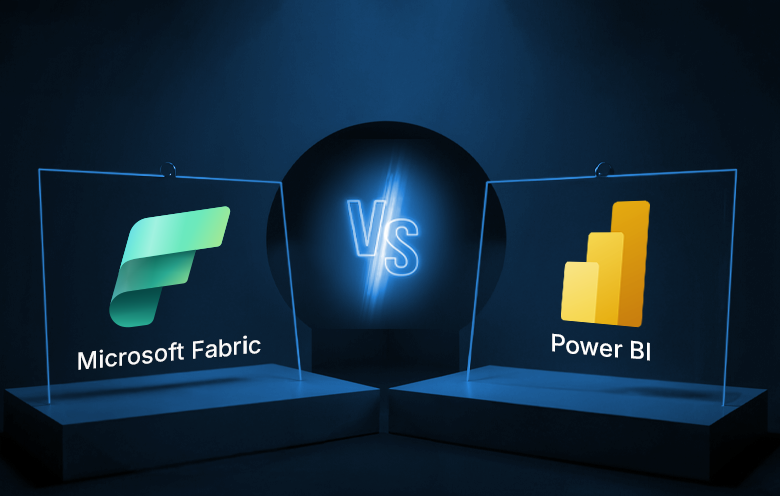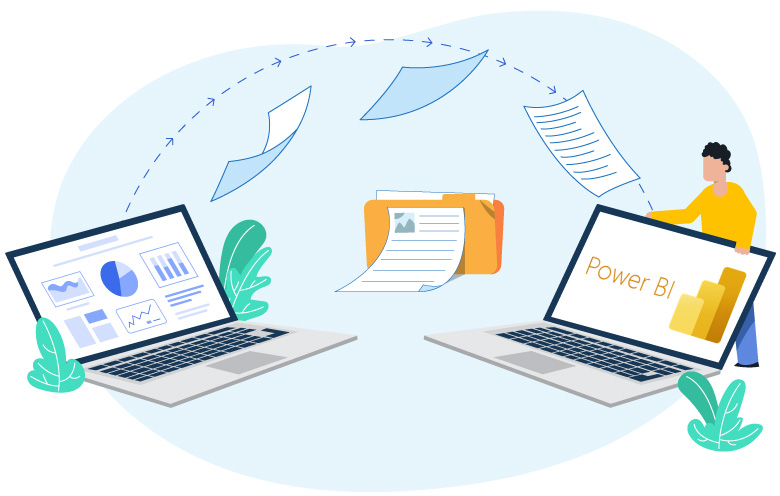

The business landscape is like a fabric—if the cloth is the underlying structure that holds everything together, then the color is what brings it to life, making it vivid and engaging. Microsoft Fabric serves as that sturdy cloth, weaving data from various sources to create a resilient foundation. Power BI brings color, transforming structured data into compelling visuals and actionable insights. Together, they form a cohesive tapestry that empowers businesses to see their operations in full detail, from the foundational layers to the insights that drive strategic decisions.
“Where there is data smoke, there is business fire” – Thomas C Redman, the ‘Data Doc’, founder and President of Data Quality Solutions
In a modern world which is ruled by data, decision making based on evidence is critical if one is to remain in contention. Due to the enormous amounts of data at businesses’ disposal, there is a need for aid to track changes, improve systems, and provide good services to clients. Thus, in this context, Microsoft Fabric and Power BI may be seen as complementary and integral tools that provide end-to-end data management and data visualization solutions aimed at helping teams explore and maximize their data. To understand how to make the most use of these instruments consulting is needed to define appropriate strategies.
Introduction to Microsoft Fabric and Power BI
Microsoft Fabric and Power BI each provide unique value in data management but serve distinct roles within the data ecosystem. Below is a closer examination of their individual capabilities.
Overview of Microsoft Fabric
Microsoft Fabric acts as a centralized platform, managing enterprise-level data through integration, storage, and advanced processing across multiple sources. It excels in data management and enables seamless support for analytics, reporting, and machine learning.
Fabric BI services provide a seamless way to integrate, store, and process enterprise-level data within Microsoft Fabric. These services enhance the platform’s capabilities by ensuring that businesses can leverage powerful analytics and reporting tools to unlock deeper insights.
Key USP of Microsoft Fabric:
Fabric’s single platform for managing diverse data needs offers scalability and security, making it ideal for companies with complex data requirements. Additionally, it integrates seamlessly within the Microsoft Azure ecosystem, making it a foundational solution for data infrastructure.
Overview of Power BI
Power BI was developed keeping in mind the growing demand for analyzing massive amounts of data and translating them into easy-to-use reports and dashboards. It is a dynamic yet intuitive resource to create meaningful, shareable insights without needing advanced technical skills.
With features like data modeling, AI-powered insights, and user-friendly visuals, Power BI empowers analysts and decision-makers, equipping them to make informed choices out of quickly interpreted data. Power BI Services offer tailored guidance and implementation, helping businesses optimize reporting, decision-making, and insights with Power BI’s full capabilities.
Key USP of Power BI:
Power BI’s unique ability to present complex data through accessible visuals supports fast, informed decision-making across business functions, from strategy to daily operations.
Best practices for seamless Power BI migration in our quick guide.
Discover how Power BI migration empowers faster decision making with real-time data, stunning visualizations, and seamless integration.

Power BI vs Microsoft Fabric: Key differences
To illustrate the distinctions between Power BI vs Fabric, here’s a side-by-side comparison that outlines their primary purposes, core features, target users, and integration capabilities:
| Feature | Power BI | Microsoft Fabric |
|---|---|---|
| Primary Purpose | Data visualization and reporting | Data engineering, integration, and storage |
| Key features | Interactive dashboards, data modeling, AI insights | Data storage, integration, and scalable processing |
| Target users | Business analysts, decision-makers | Data engineers, IT teams |
| Integration | Works seamlessly with Excel, Teams, SharePoint, and Fabric | Integrates with Azure, Power BI, and other Microsoft services |
Power BI and Fabric serve different stages in the data lifecycle. Fabric manages the backend processes for data structuring and integration, while Power BI is the final layer, transforming processed data into actionable business insights.
Organizations experienced a 27% faster time to insights when utilizing these tools, streamlining the process of obtaining actionable data and enhancing decision-making capabilities – Forrester Study
Ideal use cases
Understanding the nuances of Power BI vs Microsoft Fabric helps organizations leverage the strengths of both tools effectively. Both Power BI and Fabric add significant value but address different needs:
Power BI:
Businesses continuously strive to make sese of data they possess. Power BI implementation helps transform complex datasets into actionable insights driving smarter decision-making. Businesses strongly in need of data visualization with frequent reporting requirements find a highly resourceful tool in Power BI. It simplifies the creation of dynamic and insightful dashboards.
Fabric:
Tailored for large-scale data management and processing, Fabric is essential for businesses needing robust solutions for data integration and storage, especially where complex data ecosystems are involved.
Using both together:
In enterprise-wide analytics, Power BI and Fabric complement each other seamlessly. Fabric handles the intricate aspects of data integration and storage, while Power BI transforms this well-organized data into valuable insights that fuel strategic planning.
Business impact and ROI
When evaluating the tools in the context of Power BI vs Microsoft Fabric, both can drive transformational change, delivering a high return on investment. Fabric’s centralized structure streamlines data access and integration. It greatly reduces time spent on data preparation. Power BI enhances accessibility and enables non-technical users to quickly uncover insights and drive faster, data-informed decisions.
By reducing manual processes and enabling automation, both tools help organizations operate more efficiently, fostering a data-centered approach that enhances decision-making. Together, these tools strengthen business efficiency, maximizing productivity, and enabling long-term gains.
Final insights
In summary, when considering the landscape of data tools, the choice between Power BI vs Fabric becomes crucial for optimizing data strategy. Fabric provides a resilient foundation for managing complex data workflows, while Power BI brings that data to life, turning raw data into insights for strategic decisions. Distinct yet complementary, they embody Microsoft’s vision for integrated data solutions.
To fully harness the power of these tools, partnering with experts can make all the difference. Softweb Solutions can help you implement Microsoft Fabric and Power BI solutions tailored to your business’s unique needs, ensuring that your data works as hard as you do. Contact us to see how our expertise can elevate your data strategy.
AI Workshop
Envision how your AI Journey can be in next 1-3 years from adoption and acceleration perspective.
Enroll NowNeed Help ?
We are here for you